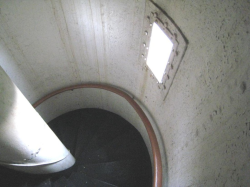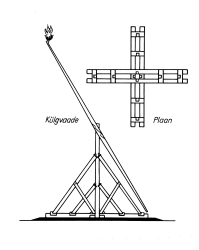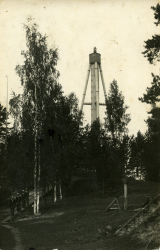Ruhnu lighthouse 





Ruhnu Lighthouse, located in the Gulf of Riga, in the east part of Ruhnu island, on Haubjerre Hill; the southernmost lighthouse in Estonia (coordinates: 57°48,081' N; 23°15,609' E). The height of the most unique lighthouse in Estonia from the bottom is 40 m, the height of the light from sealevel is 65 m. The white circular light lights up in the dark throughout the year with an interval of 4 seconds (1 second pause and 3 seconds of light), and is visible for to up to 11 miles.
The tower is made up of a cylindrical sheet metal tower (2 m in diameter) that is supported from the sides by four iron pipe buttresses mounted at an angle. There is a spiral staircase in the tower leading up to a wider terrace cylinder where the service room is located. The upper part of the terrace cylinder supports the lantern room.
The lighthouse that is administrated by the Estonian Maritime Administration has been unmanned since 2004. Estonian Border Guard Ruhnu cordon occupies the former supervisor’s house that is a part of the lighthouse complex.
Next to the lighthouse, there are service buildings built in the second half of the 19th century: keepers residence, granary, sauna, cellar, stable, well and a stone petroleum granary built in the first half of the 20th century as well as a generator building from the second half of the century.
The lighthouse complex is under national protection as a national heritage site.
History
It is known that a wooden beacon with a liftable light (a swinging-type beacon) was erected at Pärsi cape on the west coast of the island in 1646 to facilitate marine traffic in the Gulf of Riga. Similar beacons were also erected around the same time on Sõrve peninsula and at Kolka cape. At Pärsi, there was an anchoring spot for sail boats and a slip for pulling boats ashore for the winter. In 1856 it was decided to find a new location for the lighthouse on the eastern shore of the island (for more details about Pärsi lighthouse see also A settlement with the ruins of a lighthouse at Pärsi). In 1860, a hexahedral 34 meter tall frustum-shaped wooden tower was completed on Haubjerre Hill about 30 m above the sea level. In 1869 a new light device was planned to be installed in the beacon. As it was concluded, that the wooden tower was not strong enough for the new light system, a decision was made to build a metal tower instead. In 1875, parts for a new metal tower were ordered from Le Havre in France from a company called Forges et Chantiers de la Mediterranee. In order to deliver the parts over sea, a boat bridge was built on Ruhnu as well as a stone road over the dunes (partly remaining). The new lighthouse with a 40 m high gray body and a red dome started operating in 1877. During World War I the top part of the lighthouse was destroyed on May 1, 1915 by German troops. In 1921 a temporary service room was built and an acetylene gas lantern was placed on its ceiling. In 1937, the service and lantern room was reconstructed almost in its old form according to projects drawn up by engineer Ants Niilre (1909–82).
In the 1920s-30s the lighthouse keeper was a navy officer who also held several other official positions and who was called the King of Ruhnu by locals. He was also chief of the marine communication station, constable, chief of the boarder patrol, chief of customs, forester, head of the postal agency and chief of the University of Tartu weather station. This office was held by Arseni Brakmann (1922–28) and Villem Karineem (1928–40). Young men on Ruhnu undertook their compulsory military service in the Estonian Defence Forces at the lighthouse.
References
- C. Russwurm. Eibofolke oder die Schweden an den Küsten Ehstlands und auf Runö I–II. Reval, 1855
- Ruhnu ajaraamat. II. Tallinn, 2010
- J. Vali. Eesti tuletornide ajalugu. History of Estonian Lighthouses. Tallinn, 2011
Created in 2013










